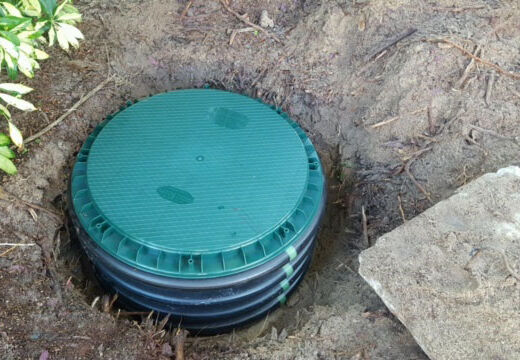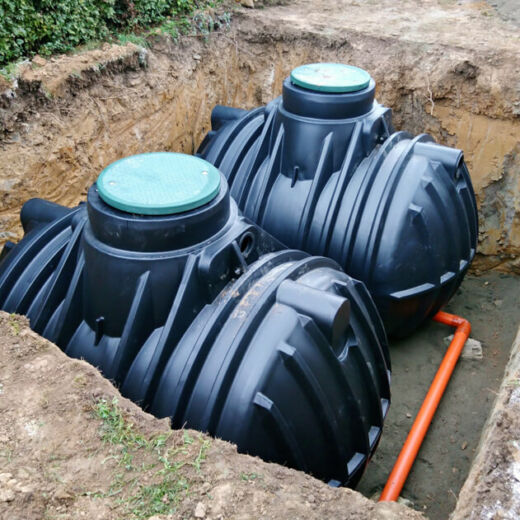Most people believe that when a septic drain field fails, you need to replace it. However, you can often fix a failed septic drainfield so long as the issues are caught in time! If you’re worried about your septic system, read on to understand the elements of a septic system, signs of drainfield failure, and what to do if your septic drainfield fails!
What are the Different Elements of a Septic System?
Septic systems typically have three core elements that make up the system. These elements are the key to the proper functioning of your septic system so as to avoid any unsavoury smells or puddles. When all elements of your septic system are working correctly, together, you can rest assured that any waste water from your septic system will be treated properly and legally.
- Treatment
- Distribution
- Final Treatment
First Element of a Failed Septic System: Treatment
The first treatment in your septic system is typically a septic tank, and there may include advanced treatment technology in the tank. The purpose of treatment in the tank is to reduce the organic content and prepare the effluent (outflowing of wastewater) for re-introduction to the environment. As your tank is treating the waste, solids are likely going to accumulate in the tank, either as sludge (accumulated on the bottom) or scum (accumulated on the top). As the sludge and/or scum layers increase in thickness, this reduces the tank’s ability to properly treat the water coming in. The more solids that have accumulated in your tank, the less the tank’s working volume will be, which reduces the effectiveness of your first line of treatment. When your tank is not properly treating the waste that goes through it, the quality of effluent being discharged is lower and likely not up to code.
Taking Care Of Your Septic System Treatment Centre
Most septic tanks need to be pumped out/cleaned every 2-5 years, depending upon their size relative to the loading. Getting your tank cleaning is an important part of ensuring the effluent is properly treated before being distributed to the rest of the system. It is also wise to install alarms in the tank to alert yourself to potential problems — ideally, while there is enough time for the problems to be addressed and resolved before they become real problems like having the system backup and send black water into your home. Make sure you get your entire septic system checked annually for both insurance purposes and peace of mind!
Second Element of a Septic System: Distribution
The second element of a septic system is the distribution of the effluent from its first line of treatment to the final treatment. As effluent is sent from the septic tank to its final treatment, the soil, it is distributed. This can be done by a pump or a gravity system. If you are noticing bad smells, pooling water, septic sewage backups, and slow draining, there is likely an issue with your septic pump or gravity system.
Taking Care of Your Septic System Distribution
Pumps and gravity systems should be checked by a professional annually. It is a lot less expensive to have a professional check your system and replace a pump than it is to clean up the mess that happens if a septic system’s distribution is…interrupted. Septic pumps also require daily care in paying attention to what you put down the drain or flush down the toilet. Pouring grease down your kitchen sink, for example, can lead to your pump getting clogged if the grease solidifies (which it definitely will in the winter). Other items like flushable wipes or sanitary products are certainly not flushable when you are dealing with a septic system.
Third Element of a Septic System: Final Treatment
The final treatment in a system occurs in the soil. Most people think of this as just “getting rid of the effluent,” but the soil is an engineered part of the system, filtering the effluent and getting it ready for reintroduction into the environment. Properly treating your effluent through the soil is a necessity, as having raw effluent that isn’t properly treated is not up to code, and can result in fines.
Most common types of final treatment
- Fields: A flat area of the property that contains laterals (either trenches or pipes that have openings to evenly distribute effluent to the soil).
- Mounds: These are essentially above-ground septic fields where layers of soil and laterals are engineered and built-up above grade to provide filtration before it meets with the native soil.
- At-grade: These systems deliver effluent that has undergone significant, additional levels of treatment, right at the surface, typically in treed/brush areas of a property, often covered by wood chips.
- Surface Discharge: This type of final treatment is no longer permitted in most areas, some properties are able to discharge effluent by a simple straight pipe to the surface where it accumulates and leeches into the soil at its own pace. Typically, surface discharge is no longer permitted in most parts of Canada. Grandfathering is a term we hear all the time and the misconception is that if this was allowed at some point on the property, that it is presently allowed. That is simply not the case.
- Cesspools and lagoons: These operate much like outhouses, they are simple final treatment areas either below grade or on the surface. Unlike surface discharge, these are engineered systems and are designed for the characteristics of the property and its soil.
Why Does a Drainfield Fail?
A drain field might fail for a number of reasons, and according to the Canada Mortgage and Housing Committee (CMHC), over 95% of drain field systems that fail from natural causes. However, these failures can be simply categorized into three failures.
Organic Failure of a Drainfield
If the buildup of organic material is not filtered by the septic tank, this can cause the drainfield to fail. If your first step of treatment is not done properly in the septic tank, causing low quality effluent to be discharged to the soil, the build up of organic waste can lead to drainfield failure.
Biomat Accumulation in a Drainfield
Biomat is a thick, tarry sludge that is secreted by the bacteria found in a septic system. Over time, the biomat accumulation will slow down and eventually prevent the flow of effluent into the soil. As the soil gets blocked up by the biomat that has accumulated and prevented proper final treatment, the effluent will likely follow the path of least resistance and go directly to the surface of your property. Biomat accumulation can cause drainfield failure by completely blocking the effluent from entering the drainfield at all.
Physical Damage to a Drainfield
You can physically damage your drainfield by driving over it or allowing livestock to compress the soil and damage the pipes in the ground. If your pipes are damaged and the soil overly compressed, the effluent cannot properly flow through the soil, resulting in puddles and a failed drainfield.
How to Spot if Your Drainfield is Failing
The most common sign that your drainfield is failing are soft, mushy areas developing above the septic drainfield which are unrelated to snow melt or heavy rain. The surface of a septic drainfield should typically feel the same as the rest of the yard does, so if you’re noticing wet spots only above the septic system, that can be a sign that you need to call a professional. Often, you can notice these issues when mowing your lawn and the tractor/lawn mower tires start to sink into the ground or spin and tear up the yard.
Other items to look out for are black slimy substances that are coming to the surface of the septic drainfield, having your septic drainfield freeze in the winter, or if you notice your septic pump running more often than usual or for longer periods of time.
Can you repair a septic drain field?
The short answer is, yes! Using newer technology, many drainfields can be repaired and replaced rather than a full system replacement. The process starts with assessing and testing all the existing equipment in your septic system. Checking pumps, floats, and alarms to ensure proper function, as well as examining the condition of the tank. Finally, we’ll check the drainfield for signs of damage — whether that’s physical damage, organic failure, or even landscaping issues. We need to know the condition of all equipment and assess whether things can be repaired, serviced, or potentially require replacement.
Once we determine whether the damage is physical (e.g.: line breaks, pump failures, etc.) or organic, we will develop a project specifically for your property, and wrap it in a lifetime guarantee.
What to Do if Your Drainfield is Failing?
If you’re noticing signs that your drainfield is failing, the first thing you should do is call SepTech Canada! We have a 24/7 live answer guarantee, and we’ll ensure that we book an on-site assessment of your current system within 24 hours. The technology we use to repair and replace septic drainfields has been used in Canada since 2005, and with this technology we have a lifetime warranty on your septic drainfield! Our technology for repairing septic systems can save you tens of thousands of dollars in replacement costs or even fines. If your drainfield is showing signs of failure, or you just want a check-up of your system, contact us today!




